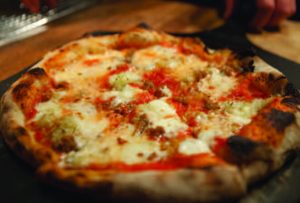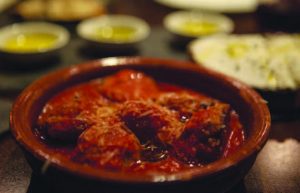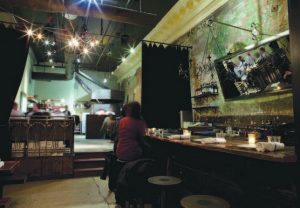With Arturo’s in Maplewood a smash success, chef Dan Richer takes his dough on the road to Jersey City
Razza
275 Grove Street, Jersey City. Phone: 201.356.9348
Open Monday through Saturday from 5:30 to 10 p.m. All major credit cards accepted. No reservations are taken. Small plates and salad range in price from $4 to $14. Pizzas are $12 to $18.
It’s late afternoon at Razza, where the art and science of flour and water converge and judgment is pronounced every day at this time.
Dan Richer, bread maestro, is removing 18 loaves from his wood-fired oven at the rear of Razza Pizza Artigianale on Grove Street in Jersey City. They are sizable loaves, but there are just 18. That’s all he bakes any day Razza is open. There’s a deja-vu to his explanation of why: “That’s what fits in my oven. We can’t do a second batch because the oven temperature wouldn’t be right and the bread wouldn’t be right. So when we run out, that’s it.”
This all merits thought, but the nose is ruling. And Richer is talking about his “10 Points for Properly Baking Bread” as he checks each loaf. Yes, it’s cooked all the way through. It’s firm and crisp on the outside.
There are big holes in the crumb. There’s no tunneling. There are ears.
Ears? Yes, Richer says. Ears.

All photos courtesy of Razza
“Every loaf needs an ear. You can pick up a loaf by an edge that rises on the top of a loaf.” He points to one loaf that lacks a proper edge. A problem with the scoring—a slash—made just before the loaves were paddle-carried into the oven. The angle of the slash? The depth of the slash?
Richer is picking up his loaves by their ears, inspecting each one. The vast majority of the 18 loaves have ears in tune with the baker’s carefully orchestrated ritual that consumes a good part of the day at Razza and has consumed the life of the man who shuns the word chef to describe his occupation and smiles, proudly, as he says, “I’m a craftsman.”
Meanwhile, the Razza front-of-the-house team—all of whom had to score 90 or better on a 15-page exam—is gathering at a table to go over the night’s specials. They include a new cocktail, “The Martinez,” which actually is an old cocktail born in California in the 1840s. It’s nigh on showtime, and people are lined up at the door of 275 Grove. They know where they want their bread buttered.
In the beginning
If the name Dan Richer sounds familiar, if the passion, focus and intense pursuit of authentic and correct is something you’ve experienced not in Jersey City, but a little closer to home, then you likely know Arturo’s, the epicenter of soul-satisfying Italian food and pizza in Maplewood. Arturo’s is also owned by Richer, and Razza is the place Arturo’s spawned.
Years ago, Richer bought the longtime suburban pizza spot, but added his own bill of fare—notably a market- and season-driven tasting menu that drew national attention and garnered Richer a spot on the list of candidates for Rising Star Chef of the Year from the James Beard Awards. But he kept working on his pizza, which was head and shoulders above the then-growing pack of pizzaiolos, though not at the level of the best pizza-maker on the planet, New Jersey’s own Anthony Mangieri.
Then, one day, after hearing about Richer, Mangieri “came in for a pizza,” Richer says.
“At that point, I was focusing more at Arturo’s on the tasting menu, the pasta-making, the rabbit-cooking. When he came in, I was so embarrassed by my pizza-making that I knew I had to get better. That visit gave me a new direction.”
A direction that took him to Jersey City, to build Razza.
Richer started studying, reading bread books, delving into the science of fermentation. He reels off the names of bakers who influenced him—from the French professor Dr. Raymond Calvel, who wrote the seminal “The Taste of Bread,” to the American author, theologian, lecturer and restaurateur Peter Reinhart—and talks of years of trials and errors.
 “In pursuit of making great pizza,” Richer says, “I learned how to make great bread.”
“In pursuit of making great pizza,” Richer says, “I learned how to make great bread.”
Inspiring Minds
Dan Richer is all about learning. He studied Japanese cuisine and, in 2005, found Sushi Yasuda on East 43rd St. in New York. Those who worship purist theologies in cuisine know Naomichi Yasuda as the best sushi chef.
Richer agrees. It was Naomichi Yasuda’s words, spoken as he served forth his fishes to Richer at his restaurant, that made the younger chef see the correlations between fish and rice and bread and butter.
“I had the same feeling with Yasuda’s sushi as I did with Anthony’s pizza: It was the rice that did it for me. What Yasuda explained to me so well was the element of time and temperature, of different fishes at different temperatures, of eating one piece at a time because only at that precise moment are both the fish and the rice at the perfect time and temperature. It has to be done at the last second and has to be eaten right away.
“When I started making the bread and the butter, I realized they, too, couldn’t be perfect if the bread was too hot or too cold or the butter too hot or too cold. That level of seriousness is something we take to our bread and butter. I take so much inspiration from Chef Yasuda.”
So much so, that when Naomichi Yasuda left his New York restaurant to the care of his sushi-chef lieutenants and went to Japan to open a minuscule temple to sushi, Richer made a point of traveling to Japan to eat there. He found Yasuda in his element—and at the height of his craftsmanship.
 He is sitting in the dining room at Razza, where he has just finished shaping his dough into the now-iconic Razza shape that resembles a French batard. He glances over at the loaves, resting in individual linen-lined baskets. He consults with Octavio Gadea, who works with him on the bread. Then he continues.
He is sitting in the dining room at Razza, where he has just finished shaping his dough into the now-iconic Razza shape that resembles a French batard. He glances over at the loaves, resting in individual linen-lined baskets. He consults with Octavio Gadea, who works with him on the bread. Then he continues.
“The thing that makes Anthony’s pizza better than anyone else’s is the dough. When you walk into his restaurant, you can smell it. It’s the dough. The essence and soul of pizza is fermenting dough.” True. Be it at Mangieri’s first Una Pizza Napoletana in Point Pleasant Beach, N.J., or the second, on East 12th Street in Manhattan, or the current Una Pizza, in San Francisco, the dough’s been the thing.
As Richer read and worked and experimented, his processes matured. He realized the key was in the fermentation. “I started fermenting everything I could; you come to understand how fermentation is controlled, how to make beneficial bacteria that out-perform the harmful bacteria.
“Innately, as humans, we’re meant to ferment. That became clear to me. It took me out of cooking and into something more like a craftsman. I feel more akin to an ironworker or a cabinet-maker than a chef. You need to understand iron, or wood, and once you understand it, you can put it back together the way you desire. The same is true with flour and water.”
When Richer says he started fermenting “everything,” he isn’t kidding. Pickles, sure. Yogurt, cheese, crème fraiche, naturally.
Then came butter. It was the natural partner for Richer’s bread which was, finally, getting to the level that made him feel good about serving it to his diners. Richer’s butter couldn’t be merely like any other premium butter, not even hyper-priced imported French butter or the good, truly good, cultured butters now sold in supermarkets. Richer’s own butter is made from cream that comes from cows pastured on a dairy farm in Pennsylvania. This dairy-farming family makes small batches of yogurt and saves the cream that rises to the top for Richer. When he speaks of that cream, the craftsman gets a little poetic.
“There’s a week in April when the cream changes,” Richer says. “There’s a time when the cows eat onion-grass and you can taste it in the cream. I love to celebrate the seasonality of our own butter. What’s the fun if it doesn’t taste different? It’s such an amazing cultured product.”
It’s what the denizens are waiting for: Razza’s bread-and-butter course.
 Razza Right Now
Razza Right Now
Before Richer took over the space, 275 Grove had been, in long succession, a bar, a wine store, a popcorn store and, way, way before, The Majestic Theater and a home for vaudeville. It is smaller than Arturo’s. Razza’s kitchen is tiny and much cooking, baking and prep work is done at the rear of the dining space, offering diners a bit of culinary theater. That suits Richer’s mission just fine: “Since our space is smaller, we focus more. That means, if we only do five things, we have to do them very well. On the surface, we look like another wood-fired pizza restaurant. Sometimes it seems like we’re nit-picking. But it’s the details that separate us.”
 Let’s Eat
Let’s Eat
First, the bread. It tastes at once nutty and then, faintly, of rye. This never dominates the palate, but scents the mind with its nuance. There’s not just a single texture to the bread, but multiple textures, from the top crust to the bottom crust—and, oh, are they ever different—to the interior crumb, with its own layers of varying textures, particularly around the holes. The initial slice is gone before you have a chance to delineate all those layers.
So you take another slice, this time remembering the butter. The butter, at once beguilingly earthy-gamey and lushly creamy, has a natural salinity that can become elusive if you go too bonkers on the texture thing. I was into my third slice before I smacked myself for over-thinking. I started eating the butter straight, talking myself into believing it’d be a kind of palate-cleanser. Then came the stracciatella, the only thing that could get me to stop eating the butter.
Razza’s special salad that day was centered around minutina, a green that’s grassy in appearance, verdant and almost juicy in flavor. Its inherent sweetness proved an irresistible counterpoint to slivers of wild mushrooms, most importantly maitakes. There’s the barest splash of balsamic vinegar and exquisite olive oil to help fuse the greens and mushrooms.
Meatballs here employ Razza’s bread as binder. They are fluffy, they resonate beef, they come swathed in sauce.
For Dan Richer’s popular Pork Pie, pig’s feet are simmered. The ensuing broth is chilled. The fat is skimmed. The result is a kind of pork “jello,” which is cut into tiny cubes. These cubes are set atop pizza dough along with bacon and shaved onion. The gelatin melts into the dough as the pie bakes in the wood-fired oven, mingling with the addition of Parmigano-Reggiano cheese into a kind of pork sauce. After one slice, Razza’s Pork Pie soars to the very top of my personal Last Meal foods’ list.
– Andy Clurfeld
Fact is, Razza does far more than five things better than anyone else around. There’s the bread, yes. The butter, check. The fire-roasted meatballs, of course. There’s also the handmade stracciatella, a cheese meant to go with the Razza bread. There are the pizzas, some of which are seasonal, and there are salads, with many ingredients sourced from local farms. There are the daily special pastas, the artisan cocktails and the short-and-sweet wine and craft beer lists.
There’s also the setting. Richer preserves the past while making comfortable the dining experience. One wall, with its layers and layers of paint jobs past, looks like an Abstract Expressionist painter got a deal on greens, blacks and browns and went to town. It’s got the kind of texture that makes touching an irresistible response, much like you have to touch Richer’s breads. There’s a wood bench, from a temple, and wood slabs from Pennsylvania barns set atop iron pedestals as tables. (Richer clearly respects his fellow craftsmen.) There’s a huge blackboard, with the Razza processes for dough, butter, meatballs and more diagrammed in chalk.
Razza’s oven is the altarpiece, where the embers fundamentally simmer all night long and a giant cast-iron door keeps oxygen at bay. “When we get here in the morning,” Richer says, “it’s at 685 degrees.” The bread starts baking when the oven reaches 550 degrees, give or take 25 degrees, but no more, no less, and the residual heat—after the bread is done and the oven is at about 525 degrees—is used to roast onions and meatballs. After that, new wood is used to stoke the fire so the oven is ready for the nightly procession of pizzas. There is a dance of aromas all day, all night at Razza.
Those aromas linger, much as they do at the restaurant homes of Dan Richer’s mentor, Anthony Mangieri, with whom he shares a fundamental philosophy: The party’s over—for the day, at least—when the fresh dough or daily bread is gone. The smart savor those aromas, the sign of a master craftsman at work.





